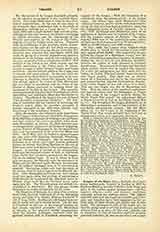

Lay Brothers .—Religious occupied solely with manual labor and with the secular affairs of a monastery or friary. They have been known, in various places and at various times, as fratres conversi, laici barbati, illiterati, or idiotae, and, though members of their respective orders, are entirely distinct from the choir monks or brothers, who are devoted mainly to the opus Dei and to study. There is some dispute as to the origin of lay brothers. They are first heard of in the eleventh century, and are stated by Mabillon to have been first instituted by St. John Gualbert at Vallombrosa, about 1038. But, though the name conversi is first applied to religious of this kind in the life of St. John Gualbert, written by the Bl. Andrea Strumensis about the end of the eleventh century, it seems certain they were instituted before the founding of Vallombrosa. St. Peter Damian indicates that servants who were also religious were set apart to perform the manual labor at Fonte Avellana, which was founded about the year 1000, while, at the monastery of Fonte Buono, at Camaldoli, founded about 1012, there were certainly brethren who were distinct from the choir monks, and were devoted entirely to the secular needs of the house.
In early Western monasticism no such distinction existed. The majority of St. Benedict’s monks were not clerics, and all performed manual labor, the word conversi being used only to designate those who had received the habit late in life, to distinguish them from the oblati and nutriti. But by the beginning of the eleventh century the time devoted to study had greatly increased, a larger proportion of the monks were in Holy orders, while great numbers of illiterate persons embraced the religious life. At the same time it was found necessary to regulate the position of the famuli, the hired servants of the monastery, and to include some of these in the monastic family. So in Italy the lay brothers were instituted, and we find similar attempts at organization at the abbey of St. Benignus, at Dijon, under William of Dijon (d. 1031) and Richard of Verdun (d. 1046), while at Hirschau the Abbot William (d. 1091) gave a special rule to the fratres barbati and exteriores. At Cluny the manual work was relegated mostly to paid servants, but the Carthusians, the Cistercians, the Order of Grandmont, and most subsequent religious orders possessed lay brothers, to whom they committed their secular cares. At Grandmont, indeed, the complete control of the order’s property by the lay brothers led to serious disturbances, and finally to the ruin of the order; but the wiser regulations of the Cistercians provided against this danger and have formed the model for the later orders. The English Black Monks have made but slight use of lay brothers, finding the service of paid attendants more convenient; but Father Taunton was mistaken in his assertion that “in those days in English Benedictine monasteries there were no lay brothers”, for they are mentioned in the customaries of St. Augustine’s at Canterbury and St. Peter’s at Westminster.
Lay brothers are now to be found in most of the religious orders. They are mostly pious and laborious persons, usually drawn from the working classes of the community, who, while unable to attain to the degree of learning requisite for Holy orders, are yet drawn to the religious life and able to contribute by their toil to the prosperity of the house or order of their vocation. Not seldom they are skilled in artistic handicrafts, sometimes they are efficient administrators of temporal possessions, always they are able to perform domestic services or to follow agricultural pursuits. The Cistercians, especially their lay brethren, are famous for their skill in agriculture, and many a now fertile spot owes its productiveness to their unremitting labor in modern as well as in medieval times.
Lay brothers are usually distinguished from the choir brethren by some difference in their habit: for instance, the Cistercian lay brother wears a brown habit, instead of white, with a black scapular; in choir they wear a large cloak instead of a cowl; the Vallombrosan lay brothers wore a cap instead of a hood, and their habit was shorter; the English Benedictine lay brothers wear a hood of a different shape from that of the choir monks, and no cowl; a Dominican lay brother wears a black, instead of a white, scapular. In some orders they are required to recite daily the Little Office of Our Lady, but usually their office consists of a certain number of Paters, Aves, and Glorias. Wherever they are found in considerable numbers they possess their own quarters in the monastery; the domus conversorum is still noticeable in many of the ruins of English monasteries.
Lay sisters are to be found in most of the orders of women, and their origin, like that of the lay brothers, is to be found in the necessity at once of providing the choir nuns with more time for the Office and study, and of enabling the unlearned to embrace the religious life. They, too, are distinguished by their different habit from the choir sisters, and their Office consists of the Little Office of Our Lady or a certain number of Paters, etc. They seem to have been instituted earlier than the lay brothers, being first mentioned in a life of St. Denis written in the ninth century. In the early medieval period we even hear of lay brothers attached to convents of women and of lay sisters attached to monasteries. In each case, of course, the two sexes occupied distinct buildings. This curious arrangement has long been abolished.
LESLIE A. ST. L. TOSE,

